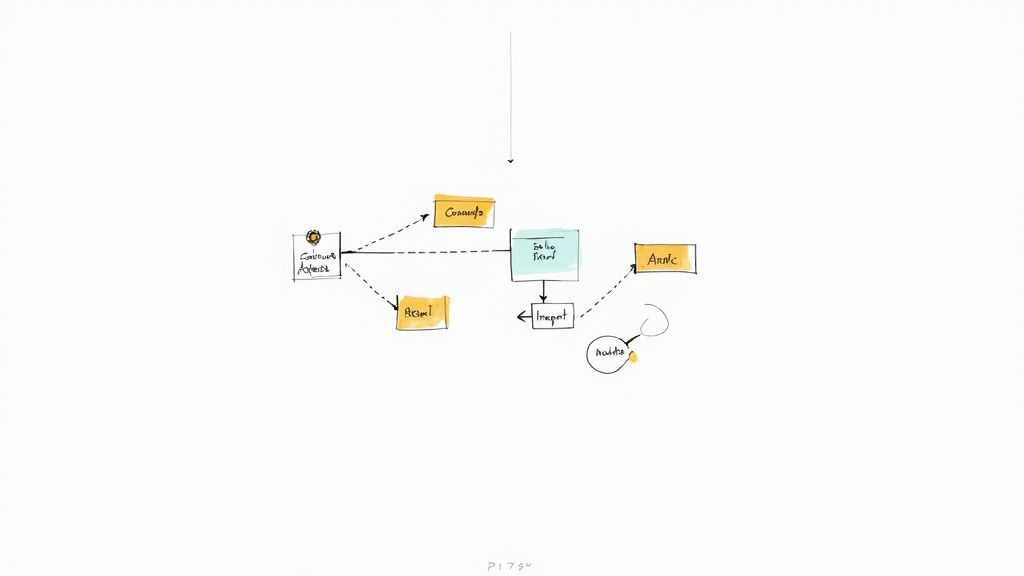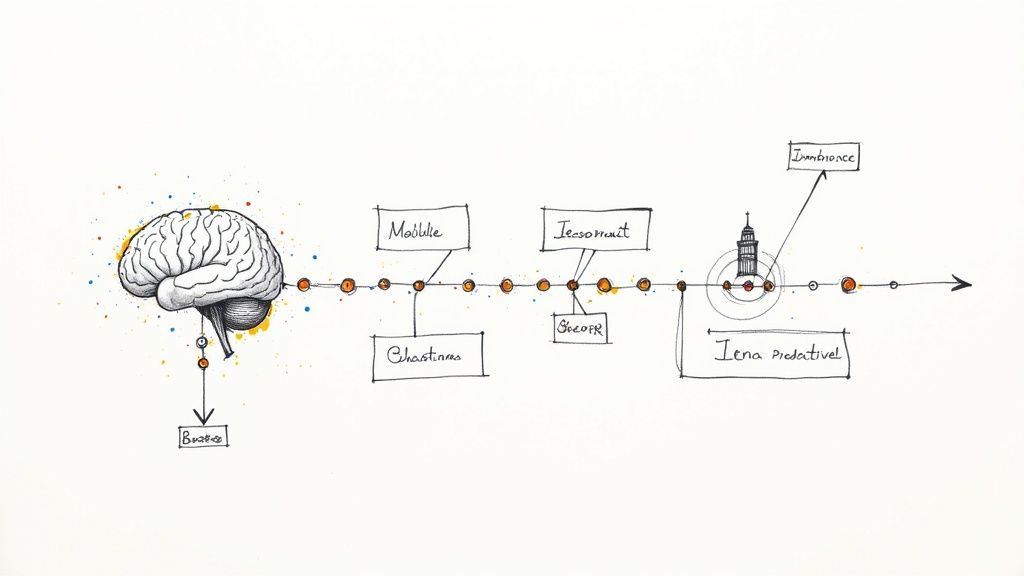
What Is Lead Qualification for Corporate Training & Development Providers?
In the competitive world of corporate training, lead qualification is the strategic process that separates high-potential clients from casual inquiries. It's how you determine which organizations are a genuine fit for your training solutions, allowing your team to focus its energy on building relationships that lead to impactful, long-term partnerships.
What Is Lead Qualification in Corporate Training and Development?
For providers of corporate training and development, lead qualification is about identifying companies with a clear, urgent need for upskilling, leadership development, or compliance training. It's the art of discerning which prospects have the budget, authority, and strategic imperative to invest in their workforce.
Without a solid qualification process, your team might spend weeks nurturing a lead from a company that doesn't have a dedicated training budget, or talking to a contact who lacks the authority to approve new programs. This leads to a stalled pipeline and wasted resources. Effective qualification ensures you're engaging organizations that are truly ready to enhance their employees' skills.
Why This Process Matters for Training Providers
A disciplined approach to lead qualification gives your team a significant competitive edge. Instead of casting a wide net, they can concentrate on prospects who are primed to become successful clients, leading to better outcomes for both parties.
The benefits are substantial:
- Higher Conversion Rates: When you engage companies with recognized training gaps, you're more likely to close deals that deliver real value.
- A More Efficient Sales Cycle: Your team avoids dead-end conversations, focusing their expertise on consulting with organizations that are actively seeking solutions.
- Stronger Client Partnerships: By aligning with clients you can genuinely help, you build a foundation for lasting relationships and repeat business.
The first step is defining your Ideal Customer Profile (ICP). This is a detailed description of your perfect client—the industry, company size, and specific learning and development (L&D) challenges they face. A clear ICP ensures your marketing and outreach attract the right kind of organizations from the start. For a deeper dive, this guide on how to qualify sales leads offers excellent insights.
To build a robust strategy, let's explore the essential components for a corporate training provider.
Key Elements of Lead Qualification for Training Providers
Implementing these elements transforms lead qualification from an intuitive guess into a repeatable, data-driven process that powers your growth.
Lead qualification is a strategic process used by businesses to evaluate prospects according to defined criteria to determine their readiness and fit as buyers. Learn more about building a powerful qualification strategy on forecastio.ai.
Navigating the Lead Qualification Funnel
Lead qualification is not a single event but a continuous process. It guides a potential client through a series of checkpoints, each one building confidence that they are the right partner for your training programs. This journey, often called the lead qualification funnel, ensures your marketing and sales teams work in perfect alignment.
The goal is to filter a broad audience of initial contacts down to a select group of high-intent, sales-ready opportunities, ensuring your team's time is invested wisely.
Here’s a simple way to visualize the core stages of this process.
This flow illustrates the journey: you first profile a lead against your ideal customer, then engage them with relevant content that addresses their training needs, and finally, analyze their actions to gauge their readiness for a sales conversation.
From MQL to SQL
The funnel is defined by key milestones that are crucial for aligning marketing and sales efforts.
Marketing Qualified Lead (MQL): This is an individual from a target company who has shown interest in your training content. For instance, a training coordinator might download your guide on "Upskilling Your Remote Workforce." They've indicated a potential need but aren't necessarily ready to buy.
Sales Qualified Lead (SQL): An MQL becomes an SQL when their actions signal a clear intent to evaluate solutions. If that same training coordinator requests a personalized demo of your interactive leadership training platform, they become an SQL. This specific action indicates an urgent need, making them a high priority for your sales team.
The key insight is that not all engagement signals equal intent. A demo request is a much stronger buying signal than a newsletter signup. This distinction is the core of lead qualification—it’s about understanding and prioritizing based on demonstrated interest.
A seamless handoff between MQL and SQL stages is vital. Marketing nurtures MQLs with valuable content, while sales focuses its consultative efforts on converting SQLs into clients. Perfecting this funnel requires a well-defined strategy, and our guide on 9 lead generation best practices can help you refine your approach.
Adopting a Lead Qualification Framework
To move from ad-hoc evaluation to a systematic process, adopting a lead qualification framework is essential. A framework provides a structured toolkit for your sales conversations, ensuring you consistently gather the critical information needed to assess a prospect's potential.
Using a framework prevents crucial details from being overlooked. It helps your team methodically determine if a prospect represents a genuine opportunity or a poor fit, saving valuable time and resources. This structured approach is the key to building a predictable and successful qualification process.
Popular Frameworks for Corporate Training
Several frameworks are widely used to structure qualification conversations in B2B environments. Familiarizing your team with models like BANT, CHAMP, and MEDDIC provides a solid foundation. You can explore more B2B qualification models on amplitude.com to find the best fit for your business.
For the corporate training and development space, two frameworks are particularly powerful:
BANT (Budget, Authority, Need, Timeline): A classic for its simplicity and effectiveness. BANT helps you quickly determine if the foundational elements for a deal exist. You ask: Do they have a dedicated L&D Budget? Does your contact have the Authority to approve training programs? Is there a pressing organizational Need? And what is their Timeline for implementation?
MEDDIC (Metrics, Economic Buyer, Decision Criteria, Decision Process, Identify Pain, Champion): For larger, more complex training engagements, MEDDIC allows for a deeper dive. It pushes you to uncover the specific Metrics the client wants to improve, such as "increase new manager retention by 20%." It also requires you to identify the true Economic Buyer and understand their entire Decision Process, ensuring you align with the goals and stakeholders driving the purchase.
By adopting a framework, every sales call becomes a strategic discovery session. You're not just presenting your services; you're diagnosing the prospect's challenges to determine if your training programs are the right solution.
How Interactive Video Streamlines Qualification
In the corporate training sector, compelling content is just the beginning. To truly connect with prospects, you need to understand their specific needs early in the process. This is where interactive video transforms lead qualification. It's not just a passive medium; it’s an active data-gathering tool that works for you 24/7.
Every interaction a viewer has with your video—the questions they answer, the modules they explore, the learning paths they choose—provides valuable data. This information offers deep, actionable insights into their training challenges and priorities, turning a one-way broadcast into a two-way diagnostic conversation.

With a platform like Mindstamp, features like clickable buttons and branching logic are built into the video experience, creating a dynamic journey that captures critical qualification data along the way.
Turning Clicks Into Qualified Leads
Imagine a prospect watches your interactive overview of corporate training solutions. They are immediately presented with a choice: "Explore Compliance Training" or "Discover Leadership Development." Their click is more than navigation; it's a direct declaration of their primary area of need.
This is the essence of what is lead qualification in the modern L&D market. With a platform like Mindstamp, you can automatically score and segment leads based on these in-video behaviors.
A prospect who clicks the 'Leadership Development' branch and answers quiz questions about managing hybrid teams is signaling a specific, urgent pain point. Their actions make them a much hotter lead than someone who passively watches a generic overview. This behavioral data automatically qualifies them and elevates their priority.
Practical Applications for Training Providers
Interactive video allows you to embed your qualification framework directly into your learning and marketing content, gathering vital information without the friction of a static form.
Here’s how you can put it into practice:
- In-Video Questions: Ask targeted questions like, "What is your team's biggest training challenge this year?" to capture explicit needs directly within the video player.
- Branching Logic: Create personalized learning paths. If a viewer selects a path designed for "teams over 500 employees," they have self-segmented and qualified based on company size.
- Lead Capture Forms: Place a short form before a high-value module to convert engaged viewers into MQLs at their moment of peak interest.
By leveraging these features, you transform every video view into a qualification opportunity. To succeed, you must understand how to maximise the ROI of video content in your sales funnel.
Dive deeper into modern qualification strategies in our guide on how to qualify leads.
The Future of Qualification with AI and Behavioral Data
Lead qualification is evolving beyond static firmographics like company size and job title. The future lies in dynamically understanding buying intent through AI and rich behavioral data. This shift means you no longer have to guess who is interested—their digital actions tell the story.

Imagine knowing a Head of L&D has re-watched your interactive demo on new manager training for the third time this week. Or that they spent ten minutes exploring the analytics module in your platform overview. These digital footprints are powerful indicators of intent to buy.
The future of sales intelligence is not just knowing who a lead is, but understanding what they are doing right now. AI is the engine that analyzes these subtle behavioral cues at scale, transforming noisy data into clear priorities for your sales team.
Predictive Scoring with AI
AI-powered platforms analyze these digital interactions to score leads with high accuracy, enabling your team to focus on prospects who are actively signaling their readiness to engage. These systems track high-intent behaviors like visits to pricing pages, demo requests, and repeated engagement with specific video content.
This data-driven approach yields significant results. Studies show that AI-enabled qualification can increase sales conversions by as much as 451%. It's the difference between pursuing cold leads and engaging prospects who are already exploring solutions. You can find more details on how AI is transforming lead qualification on agentiveaiq.com.
To leverage these signals, you must understand the patterns behind the clicks. Learn more in our guide on what is behavioral analytics and see how this data can fuel your entire sales process.
When you combine AI with behavioral insights from interactive content, you create a hyper-efficient qualification machine.
Common Questions About Lead Qualification
Even with a well-defined strategy, questions will arise as you implement your lead qualification process. Let's address some of the most common challenges for corporate training providers.
How Do I Create an Ideal Customer Profile for My Training Business?
Start by analyzing your best existing clients. Identify the common characteristics of your most successful partnerships.
- Company Data: What are their firmographics? Do you primarily serve tech companies with 500-2,000 employees, or are they smaller organizations in the healthcare sector?
- Key Contacts: Who is your champion within the company? Is it typically an L&D Manager, a VP of Human Resources, or a department head experiencing a specific pain point?
- Business Challenges: What specific problem did your training solve? Were they struggling with onboarding, leadership development, or regulatory compliance?
Once you have this data, interview some of these clients. Ask about their goals, challenges, and what they value in a training partner. This qualitative insight is invaluable for building a persona that allows you to attract the right organizations.
What Is the Biggest Mistake in Lead Qualification?
The single biggest mistake is a poor handoff between marketing and sales, which almost always stems from a lack of a shared definition of a "qualified" lead.
Marketing might generate a high volume of leads from an ebook download, but sales discovers these individuals are not ready for a conversation. This misalignment leads to frustration, wasted effort, and missed revenue targets.
To solve this, marketing and sales must collaborate to establish a clear, unified definition for a Marketing Qualified Lead (MQL) and a Sales Qualified Lead (SQL). This service-level agreement (SLA) is the foundation of a smooth, productive pipeline.
Without this alignment, you create internal friction that slows down growth.
Can I Qualify Leads Effectively with a Small Team?
Absolutely. Effective lead qualification is about working smarter, not just harder. You don't need a large team or complex enterprise software.
Start by integrating a simple framework like BANT (Budget, Authority, Need, Timeline) into your discovery calls to add structure. Use your website analytics to identify which companies are spending the most time on your solution pages.
Technology can be a powerful force multiplier. Interactive video platforms like Mindstamp automate a significant portion of the data gathering. By embedding qualification questions directly into your videos, you can capture valuable insights from prospects without manual intervention, freeing your team to focus on high-value conversations.
How Often Should I Revisit My Qualification Criteria?
Your qualification criteria should be a living document, not a static one. Markets shift, your business goals evolve, and your understanding of your ideal customer will deepen over time.
As a best practice, review and refine your criteria at least once or twice a year. It's also wise to conduct a review after launching a new training program or when you notice a shift in market trends. Each time you onboard a great new client, use the insights from that partnership to sharpen your ICP and scoring models. This ensures your process remains relevant and optimized to attract your most valuable customers.
Ready to turn your training and development videos into a powerful lead qualification engine? With Mindstamp, you can embed questions, create branching pathways, and capture viewer data to automatically identify your most promising prospects.
Get Started Now
Mindstamp is easy to use, incredibly capable, and supported by an amazing team. Join us!



Try Mindstamp Free










